Bluebirds, known for their vibrant blue feathers, are a common sight in gardens and parks across the United States.
These birds, also known as Eastern bluebirds, can be found year-round in many regions of the country, and are a popular species for birdwatchers and nature enthusiasts.
With their striking colors and cheerful chirps, bluebirds are a welcome addition to any backyard or natural area.
In this article, we will explore the characteristics, habitat, behavior, and conservation efforts of bluebirds in the United States.
1. Mountain Bluebird
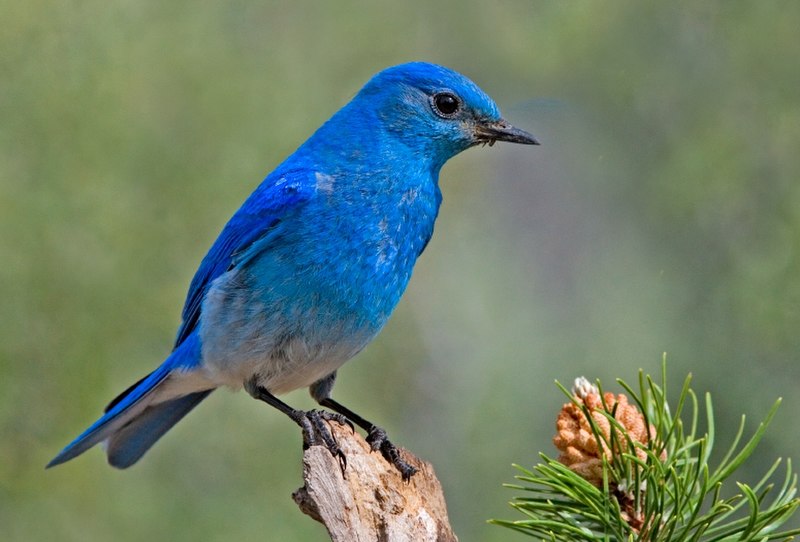
The Mountain Bluebird is a beautiful sight to behold. It has bright turquoise-blue wings and tail, with a light underbelly, grey crown, and breast, black eyes, and thin bills.
During the fall season, its plumage changes slightly – females have duller blue wings and tails, as well as a grey throat and back.
As they migrate across western North America during springtime these birds can be found in mountainous districts where they feed on insects such as grasshoppers or crickets collected from meadows or fields of grain.
They also enjoy eating berries when available. Through their stunning colors, this species adds vibrancy to any landscape it traverses through – truly an incredible creature of nature.
Scientific classification:
| Kingdom | Animalia |
| Phylum | Chordata |
| Class | Aves |
| Order | Passeriformes |
| Family | Turdidae |
| Genus | Sialia |
| Species | S. currucoides |
Also Featured In: Birds Commonly Found in Northern California, Birds that Found in the Yellowstone
2. Eastern Bluebird
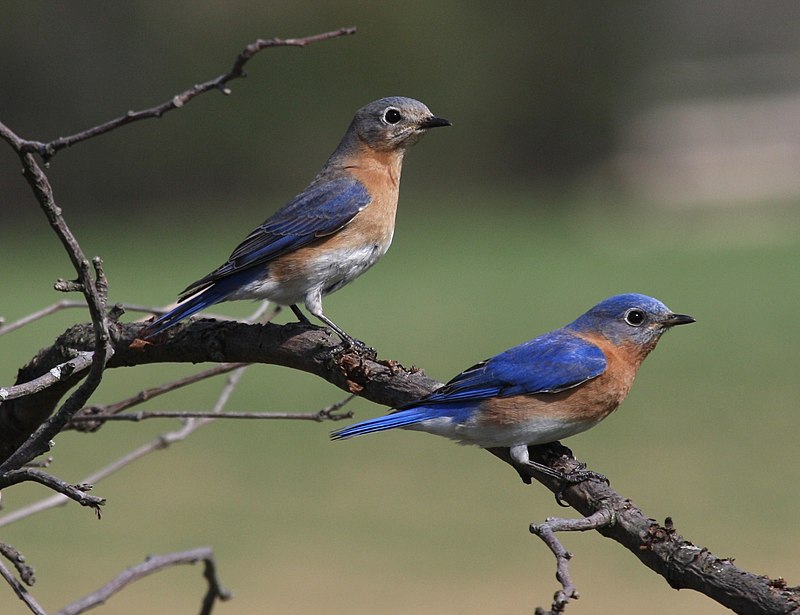
The Eastern bluebird is a small migratory thrush that can be found in open woodlands, farms, and orchards across North America.
The male has bright-blue breeding plumage which makes it easily recognizable by birders.
It produces melodious songs such as jeew, chir-wi, and chiti WEEW wewidoo.
This popular species was declared the state bird of Missouri back in 1927 due to its beauty and charm.
In addition to being beautiful, these birds are also beneficial for farmers because they eat insects like grasshoppers and beetles which damage crops.
They nest in cavities so providing nesting boxes helps them thrive even more.
With their vibrant colors, sweet melodies, and helpful nature it’s easy to see why the Eastern Bluebird is beloved worldwide.
Scientific classification:
| Kingdom | Animalia |
| Phylum | Chordata |
| Class | Aves |
| Order | Passeriformes |
| Family | Turdidae |
| Genus | Sialia |
| Species | S. sialis |
Also Featured In: Birds Live in Arkansas, Birds that Migrate through Illinois in the Spring
3. Blue Jay

The Blue Jay is a beautiful bird that resides in the eastern and central United States, as well as Newfoundland Canada.
They have an unmistakable blue colored plumage with white markings on their heads and wings.
These birds are highly adaptable to different habitats ranging from deciduous forests to urban areas.
As part of the Corvidae family, they are known for being intelligent problem solvers who will often use tools or mimic vocalizations of other species like hawks when defending their territories.
Their diet consists mostly of insects, seeds, and nuts but can also include small vertebrates such as frogs or lizards if food resources become scarce.
Overall these birds provide much-needed color to our environment while playing important roles in maintaining healthy ecosystems through pollination services and seed dispersal activities.
Scientific classification:
| Kingdom | Animalia |
| Phylum | Chordata |
| Class | Aves |
| Order | Passeriformes |
| Family | Corvidae |
| Genus | Cyanocitta |
| Species | C. cristata |
Also Featured In: New Hampshire Birds You Should Know, Most Common Nature Birds
4. Belted Kingfisher
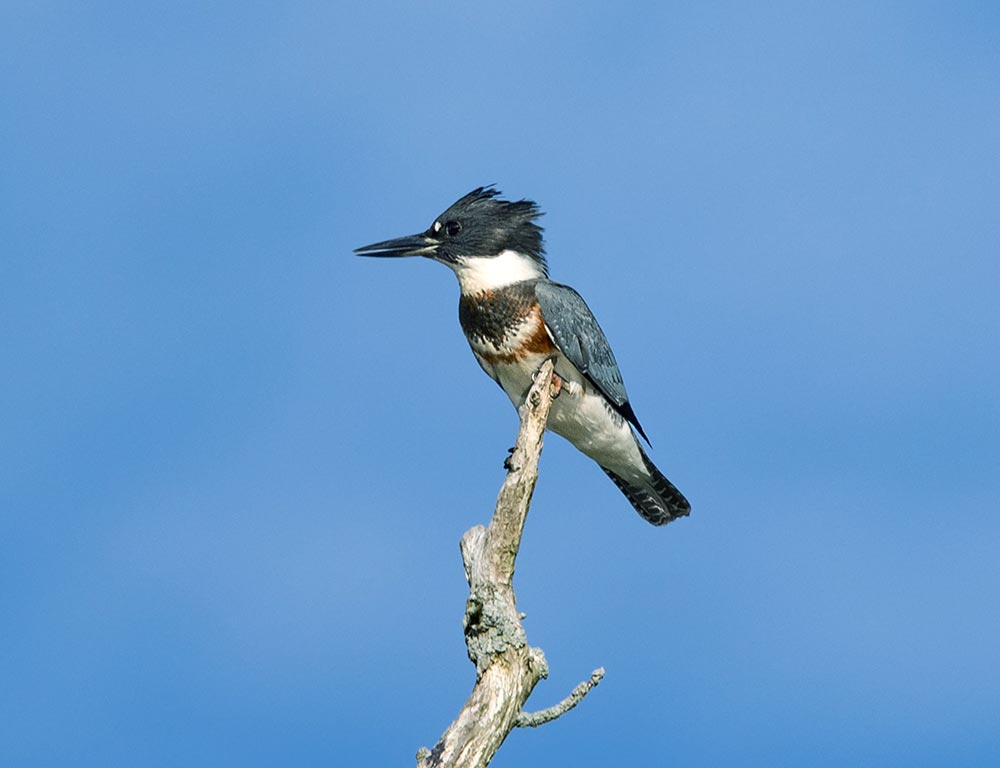
The belted kingfisher is a large, eye-catching bird native to North America. It belongs to the family Alcedinidae and has been divided into three subfamilies by recent research.
The species was first described in 1758 by Carl Linnaeus in his Systema Naturae.
This water Kingfisher stands out for its size as well as its striking plumage; males are bright blue on top with white below and females have rusty brown backs and wings with a thick black breast band across their chest.
They also possess an impressive call that can be heard from quite far away.
Belted kingfishers feed mainly on small fish but will sometimes also eat crustaceans, insects, or even amphibians if they come across them while hunting around rivers or streams.
All in all, this is truly one remarkable bird that deserves our admiration.
Scientific classification:
| Kingdom | Animalia |
| Phylum | Chordata |
| Class | Aves |
| Order | Coraciiformes |
| Family | Alcedinidae |
| Subfamily | Cerylinae |
| Genus | Megaceryle |
| Species | M. alcyon |
Also Featured In: Most Popular Bird Species in North America, Long Island Birds You Should Know
5. Common Grackle

The Common Grackle is a large icterid bird commonly found in North America. It has an iridescent head and pale yellow eyes, which are framed by its long dark bill and long tail.
Males typically have more vivid colors on their heads than females do. These birds can be seen across much of the continent, in fields, forests, wetlands – even urban areas.
They form huge flocks to search for food such as grains or insects that they catch with their bills.
The grackles may also scavenge from human sources like garbage dumps or picnic tables if available. With its colorful plumage and distinct call it’s easy to spot this species amongst other birds.
Scientific classification:
| Kingdom | Animalia |
| Phylum | Chordata |
| Class | Aves |
| Order | Passeriformes |
| Family | Icteridae |
| Genus | Quiscalus |
| Species | Q. quiscula |
Also Featured In: Central Texas Birds, Common Central Park Birds
6. Great Blue Heron

The Great Blue Heron is a majestic wading bird found in many parts of North America, Central America, the Caribbean, and even as far away as the Galapagos Islands.
It has an impressive wingspan which can reach up to six feet wide. Its feathers are mainly bluish-gray with brownish streaks on both its neck and chest while its head displays white plumes.
The adult herons can also be identified by their yellow bill and legs.
They live near bodies of water such as lakes, marshes, or rivers where they feed on fish using a spear-like motion with their sharp bills.
An all-white population exists only in South Florida and the Florida Keys making it quite unique.
Scientific classification:
| Kingdom | Animalia |
| Phylum | Chordata |
| Class | Aves |
| Order | Pelecaniformes |
| Family | Ardeidae |
| Genus | Ardea |
| Species | A. herodias |
Also Featured In: Water Birds Live around Us, Flight Birds You Should Know
7. Black-throated Blue Warbler
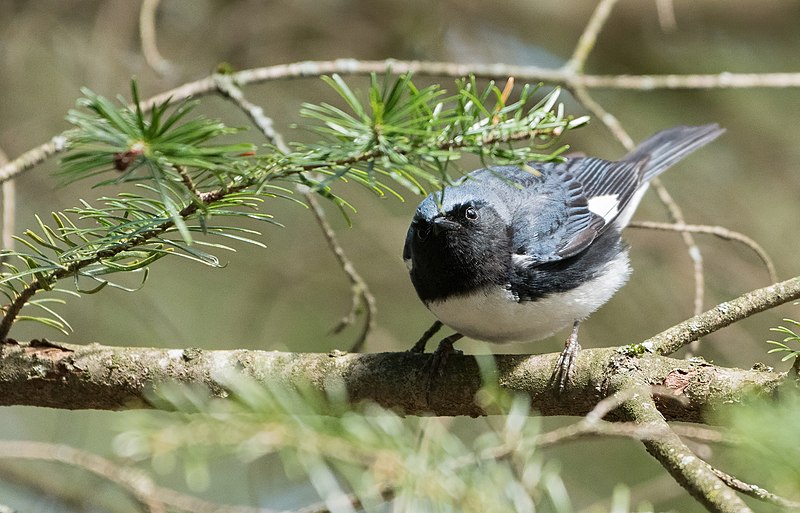
The black-throated blue warbler is a beautiful bird from the New World Warbler family. It breeds in deciduous and mixed coniferous forests of eastern North America, migrating to islands in the Caribbean and Central America during winter months.
This small passerine has an impressive plumage with bright blue upperparts and white underparts that contrast sharply against its coal-black throat patch.
Its wings are dark greyish or olive green with two bold white wing bars on each side; while its tail feathers are yellowish or whitish underneath but gray above.
These birds feed mainly on insects such as moths, beetles, ants, grasshoppers, and spiders which they catch by flycatching from low branches or shrubs within their habitat range.
Rarely found in western Europe, it is considered to be non-indigenous there although some individuals have been observed over short periods.
Scientific classification:
| Kingdom | Animalia |
| Phylum | Chordata |
| Class | Aves |
| Order | Passeriformes |
| Family | Parulidae |
| Genus | Setophaga |
| Species | S. caerulescens |
Also Featured In: Most Common Types of Birds Found in Cuba, Birds of Nova Scotia
8. Blue Grosbeak
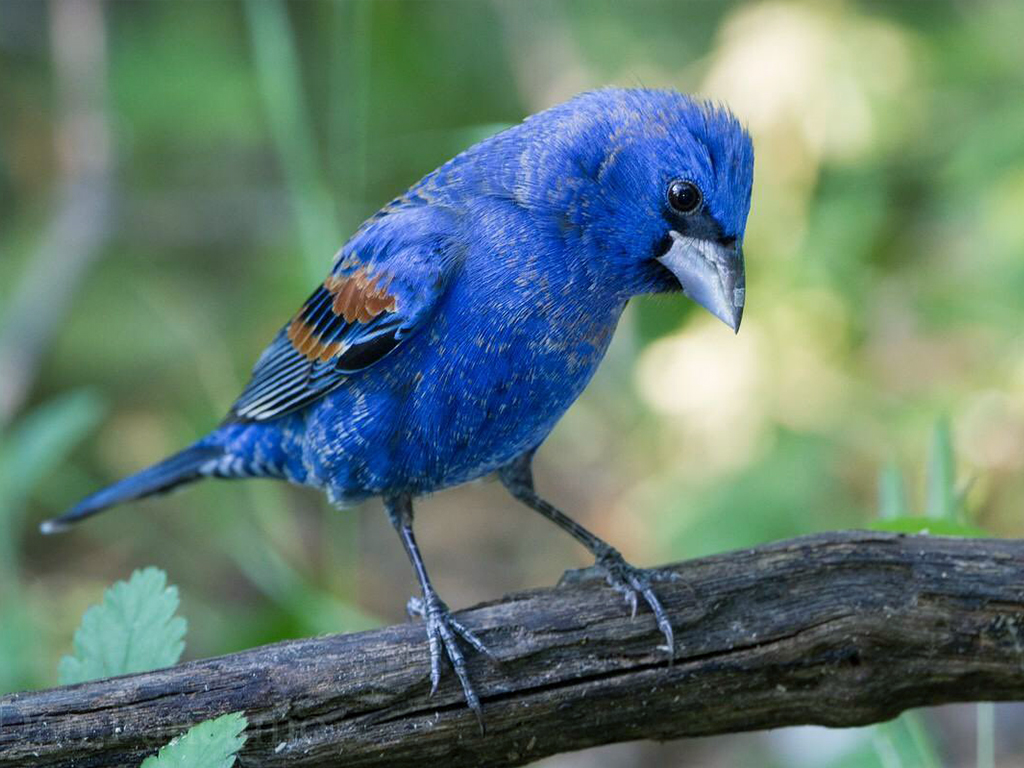
The Blue Grosbeak is a medium-sized North American passerine bird from the Cardinalidae family. It has striking plumage, with males showing off an impressive blue coloration and two brown wing bars.
Females are mainly brown with scattered blue feathers on the upperparts, but they also have two brown wing bars like males do.
During summer months these birds can be found in northern Mexico and the southern United States where they breed, while during wintertime they migrate to Central America for resting purposes.
This beautiful species of bird is easy to spot due to its vibrant colors making it a popular sight amongst wildlife observers.
Scientific classification:
| Kingdom | Animalia |
| Phylum | Chordata |
| Class | Aves |
| Order | Passeriformes |
| Family | Cardinalidae |
| Genus | Passerina |
| Species | P. caerulea |
Also Featured In: El Salvador Birds, Birds that Live in Mississippi
9. Indigo Bunting
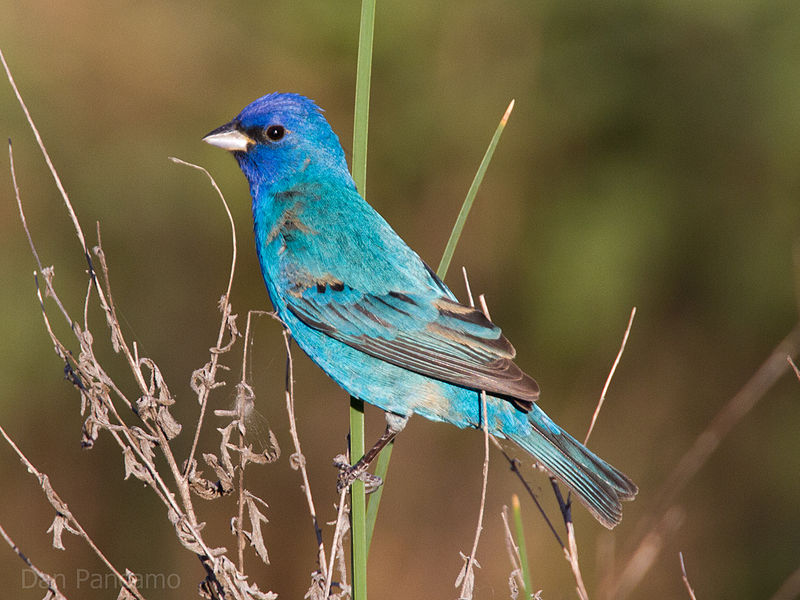
The Indigo Bunting is a small bird in the cardinal family, found throughout North and South America.
It has an unmistakable bright blue plumage that stands out against its natural habitat of farmland, brush areas, and open woodland.
During breeding season it can be seen from southern Canada to northern Florida while during winter months it migrates south towards Central and Northern South America.
The Indigo Bunting prefers to migrate at night using the stars as navigation aids.
This species feeds on insects and seeds which they find near the ground or catch mid-flight with their agile wingspan.
An iconic sight for many farmers across both continents, these birds are a welcome addition to any backyard oasis or wildflower meadow.
Scientific classification:
| Kingdom | Animalia |
| Phylum | Chordata |
| Class | Aves |
| Order | Passeriformes |
| Family | Cardinalidae |
| Genus | Passerina |
| Species | P. cyanea |
Also Featured In: Georgia Birds, Birds in Iowa Spring
10. Blue-Gray Gnatcatcher
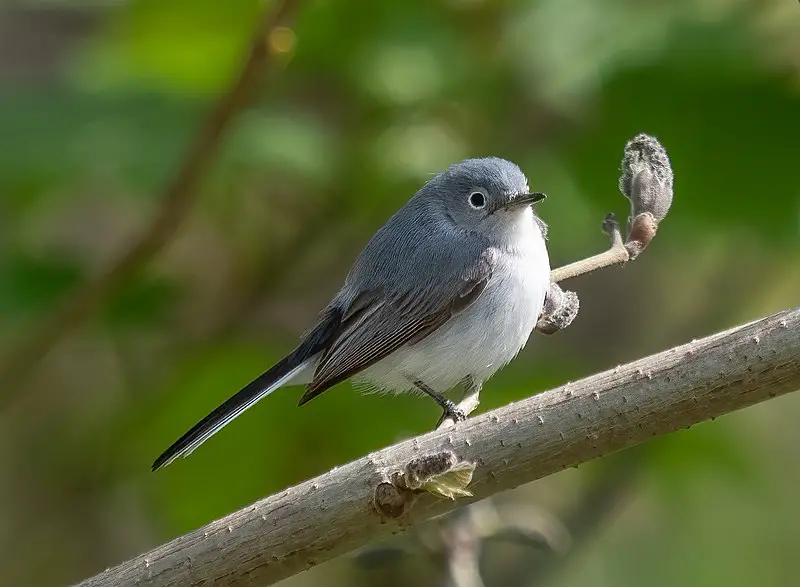
The Blue-gray Gnatcatcher is a beautiful small songbird native to North America. It has a length of 10–13 cm (3.9–5.1 in), a wingspan of 6.3 in (16 cm) and weighs only 5–7 g (0.18–0.25 oz).
Males have blue-gray upperparts with white underparts, slender dark bills, and long black tails edged in white; females are less vibrant but still eye-catching.
Juveniles are brownish-gray overall but may show some hints of adult coloration around their tails or shoulders as they mature into adulthood.
Their diet consists mainly of insects which they catch while flitting through air like tiny darts.
This stunning species can be found anywhere from woodlands to urban parks so keep your eyes peeled for these delightful creatures on your next outdoor adventure.
Scientific classification:
| Kingdom | Animalia |
| Phylum | Chordata |
| Class | Aves |
| Order | Passeriformes |
| Family | Polioptilidae |
| Genus | Polioptila |
| Species | P. caerulea |
Also Featured In: Chickadees Birds, Birds That Live in Colorado
11. Tree Swallow
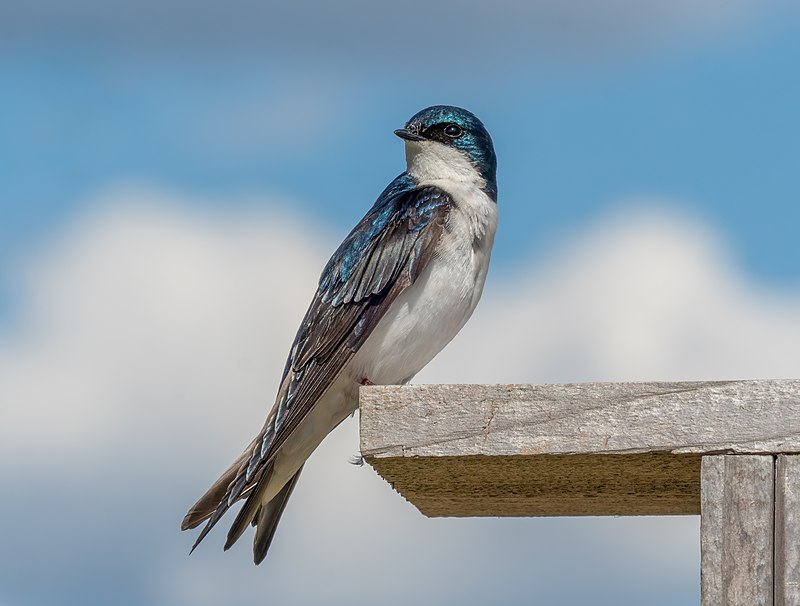
The Tree Swallow is a migratory bird of the Hirundinidae family, first described by French ornithologist Louis Vieillot in 1807. It has glossy blue-green upperparts and white underparts with iridescent violet on its throat and breast.
Its wings are blackish above with pale grey below, while its tail feathers are blackish-blue with white edges.
During breeding season they build cup-shaped nests out of grasses or twigs which are lined with animal hair or fur found near their nesting sites.
They feed mainly on insects such as flies and beetles that they catch while flying over fields or water surfaces during summer months when food is abundant for them to survive migration back southward in wintertime.
The tree swallow is an important part of our environment both aesthetically and ecologically due to its insectivorous diet helping keep pest populations low in certain areas where agricultural crops may otherwise be damaged without these birds around.
Scientific classification:
| Kingdom | Animalia |
| Phylum | Chordata |
| Class | Aves |
| Order | Passeriformes |
| Family | Hirundinidae |
| Genus | Tachycineta |
| Species | T. bicolor |
Also Featured In: Swallows Species, Blue Birds You’ll Found around Us
12. Western Bluebird
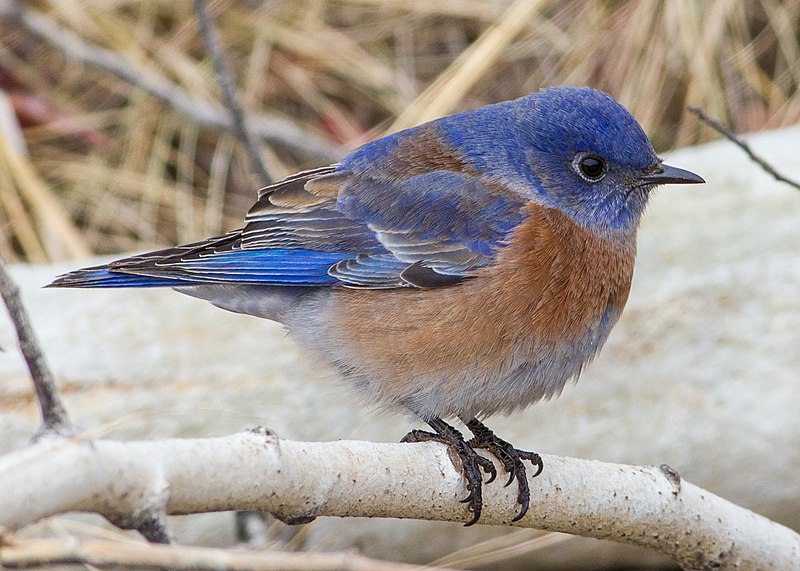
The Western Bluebird is a small North American thrush that was formally described by English naturalist William John Swainson in 1832.
It has six subspecies and measures 15 to 18 cm long, with the adult male being bright blue on top and light orange-brown underneath.
Its wings have white bars which contrast against its bright plumage. The female is duller overall but retains the same wing pattern as its counterpart.
In addition, it also sports an attractive reddish patch near its bill area when breeding season arrives.
This species can be found inhabiting open woodlands, grassy meadows, or agricultural areas of western America from Alaska southwards into Mexico and Guatemala where they feed mainly on insects such as beetles, flies, ants, etc.
All in all this gorgeous bird adds colour to any environment.
Scientific classification:
| Kingdom | Animalia |
| Phylum | Chordata |
| Class | Aves |
| Order | Passeriformes |
| Family | Turdidae |
| Genus | Sialia |
| Species | S. mexicana |
Also Featured In: Thrush Species, Common Southern Californian Birds
13. California Scrub Jay
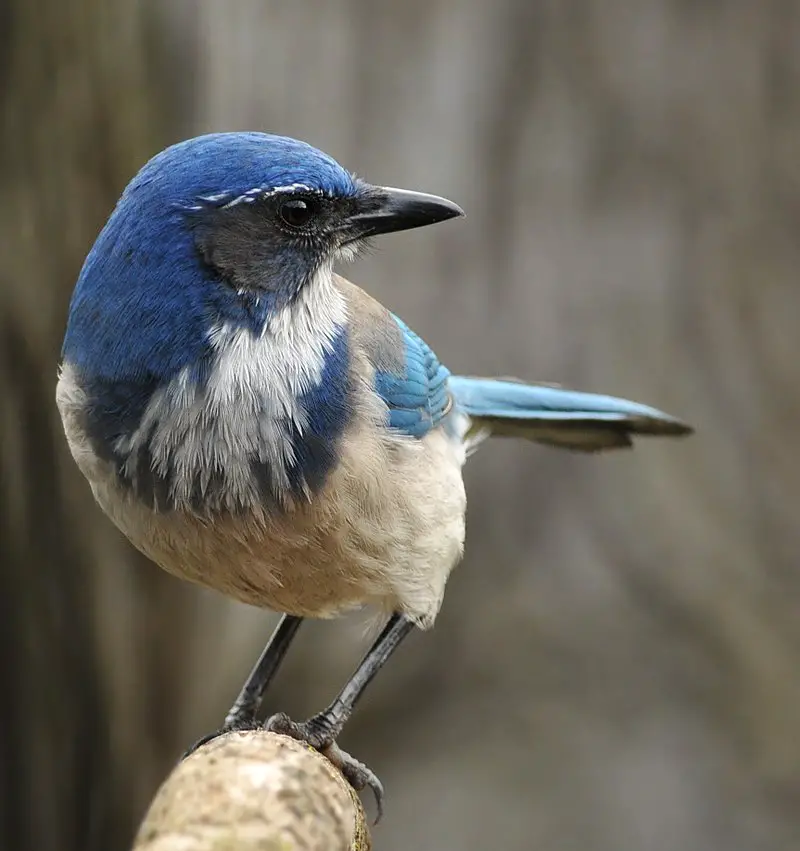
The California scrub jay is a species of bird native to western North America. It can be found from southern British Columbia down through California and western Nevada near Reno, up to the west beyond the Sierra Nevada range.
This beautiful blue feathered bird was once categorized with Woodhouse’s scrub jay as the “western scrub jay” along with island scrub jays.
The California Scrub Jay has distinctive features such as its greyish-blue feathers on its head, wings, and tail; white cheeks; dark bill; and strong legs for perching in trees which makes it stand out among other birds in its family.
Scientific classification:
| Kingdom | Animalia |
| Phylum | Chordata |
| Class | Aves |
| Order | Passeriformes |
| Family | Corvidae |
| Genus | Aphelocoma |
| Species | A. californica |
Also Featured In: Common Californian Birds, Summer Birds that Live around Us
14. Painted Bunting
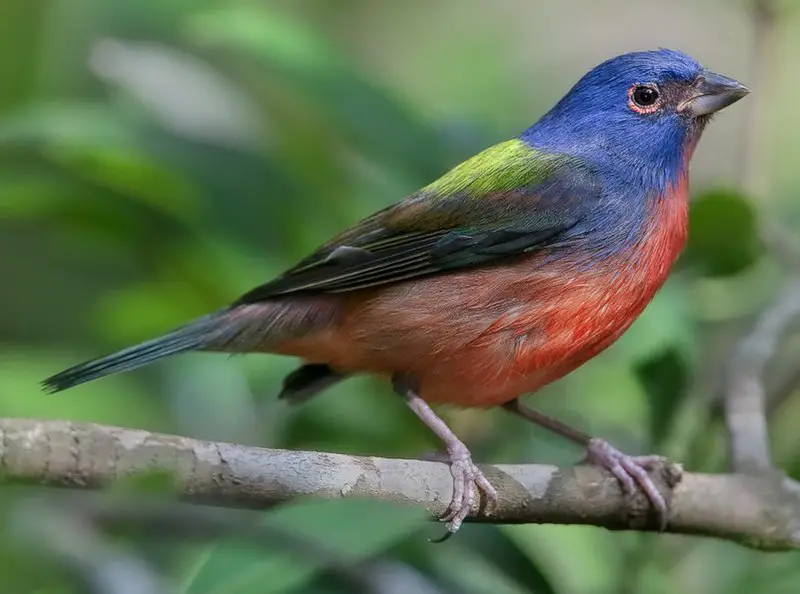
The Painted Bunting is an eye-catching bird from the Cardinal family, native to North America. It was first described by Carl Linnaeus in his eighteenth-century Systema Naturae.
The males of this species are particularly striking; they have brightly coloured plumage which only appears after their second year of life and can be distinguished from female birds through close inspection.
These colorful songbirds are a delight for any avid birder, with their vibrant hues bringing joy to nature lovers everywhere.
They often inhabit woodland areas where there is plenty of seed and insects available for them to feed on – as well as some shrubbery so that they can hide away safely when needed.
Scientific classification:
| Kingdom | Animalia |
| Phylum | Chordata |
| Class | Aves |
| Order | Passeriformes |
| Family | Cardinalidae |
| Genus | Passerina |
| Species | P. ciris |
Also Featured In: Texas Birds, Flocks Birds around Us
15. Florida Scrub Jay
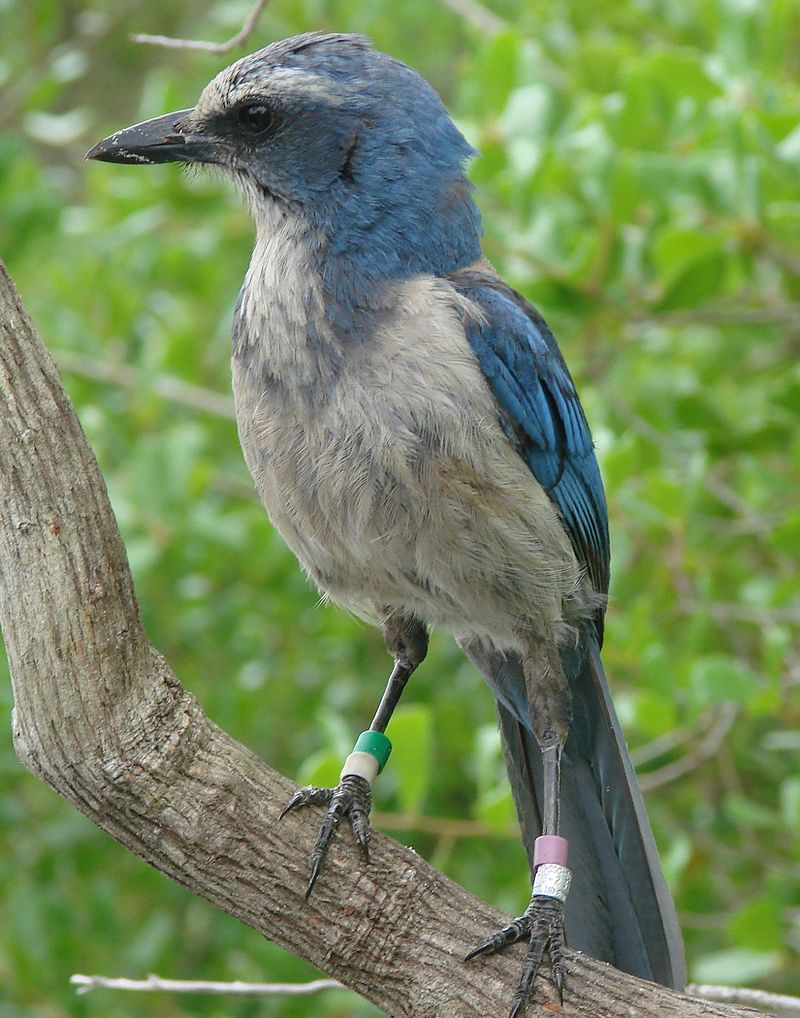
The Florida scrub jay is an important native bird species, endemic to the state of Florida and found nowhere else in the world. It has been around for at least two million years, making it a unique part of Floridian wildlife.
These birds are known for their distinctive blue-gray coloration with lighter underparts and white streaks across their wings.
They also have long legs and short tails that help them move quickly through open areas like sandy prairies or pinelands.
Scrub Jays feed mainly on insects but will take advantage of any food sources they find including fruit, nuts, eggs, small reptiles, or amphibians if available.
Due to its restricted range, this species is keenly sought by birders who want a chance to spot one in its natural habitat.
Scientific classification:
| Kingdom | Animalia |
| Phylum | Chordata |
| Class | Aves |
| Order | Passeriformes |
| Family | Corvidae |
| Genus | Aphelocoma |
| Species | A. coerulescens |
Also Featured In: Florida Birds, Birds that Live around Central Florida
16. Cerulean Warbler
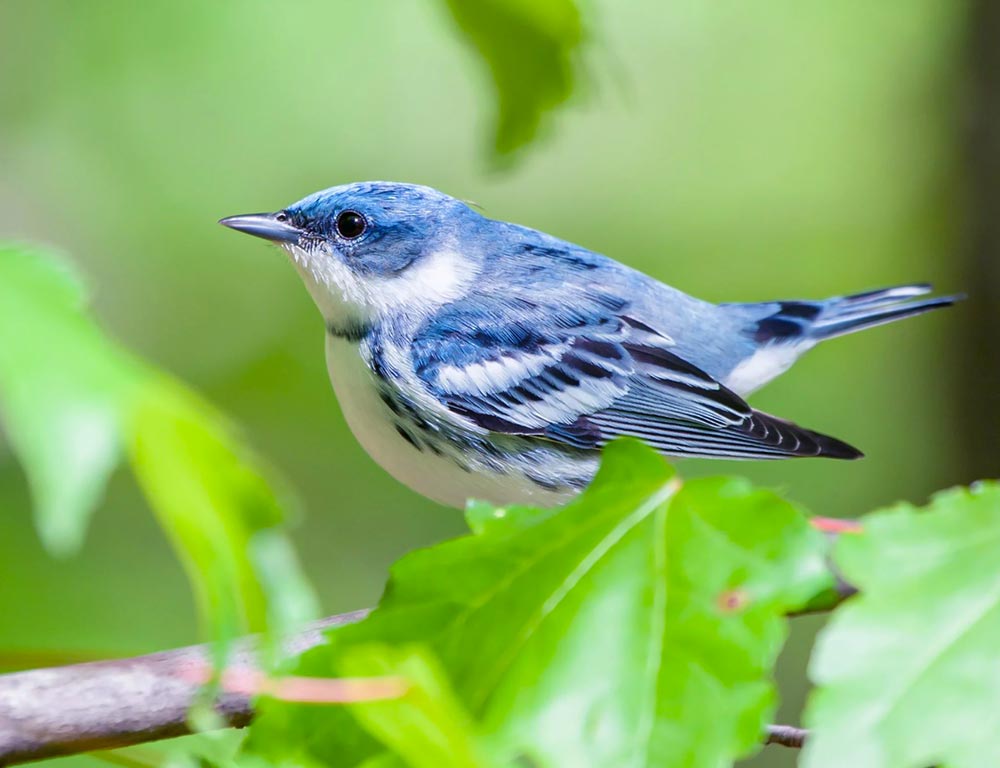
The Cerulean Warbler is a small songbird in the Parulidae family. It migrates long distances, breeding in eastern North American hardwood forests and spending its non-breeding season on the east slope of the Andes in South America.
This bird displays strong sexual dichromatism with adult males having vivid cerulean blue and white upperparts with black streaks running down their neck to chest area.
Females have an olive green color above with yellowish tones beneath them, along with some dark streaks as well.
These birds feed mainly on insects but also consume fruits during migration or when rearing young ones.
They make nests near tree trunks and lay three to five eggs per clutch which hatch after about 10 days of incubation by both parents.
The Cerulean Warbler is classified as Near Threatened due to human disturbances such as habitat loss caused by deforestation amongst other factors like climate change that threaten this species’ survival.
Scientific classification:
| Kingdom | Animalia |
| Phylum | Chordata |
| Class | Aves |
| Order | Passeriformes |
| Family | Parulidae |
| Genus | Setophaga |
| Species | S. cerulea |
Also Featured In: Louisiana Birds, Birds Commonly Found in New York
17. Northern Parula
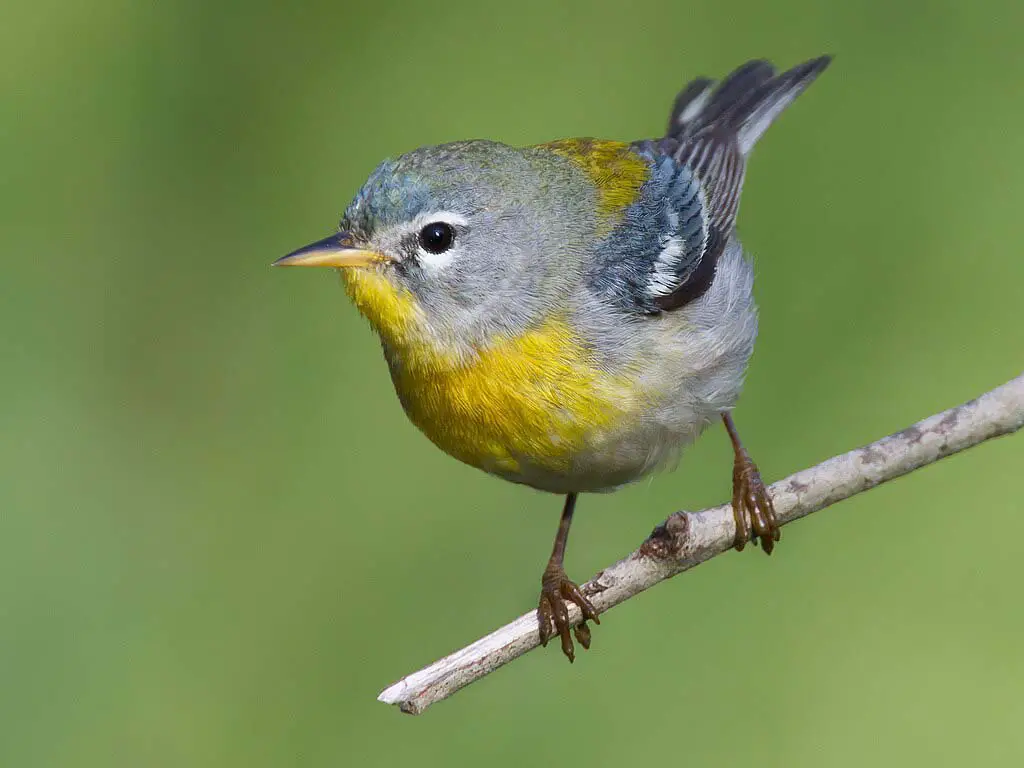
The Northern Parula is a small, migratory warbler native to North America. It measures between 4.3 and 4.9 inches in length and has a wingspan of 6.3-7.1 inches wide.
Its plumage consists mainly of yellowish-green upper parts with an orange patch on its chest as well as blue crowns for males during the breeding season.
Females have duller colors than their male counterparts overall but are still quite striking from afar.
This species breeds primarily in eastern Canada down through Florida, though some northern populations may migrate southward come wintertime while others stick around year round depending on the weather conditions they face each year – truly amazing adaptability sets them apart from other birds in this region.
Scientific classification:
| Kingdom | Animalia |
| Phylum | Chordata |
| Class | Aves |
| Order | Passeriformes |
| Family | Parulidae |
| Genus | Setophaga |
| Species | S. americana |
Also Featured In: Maine Birds, Adirondack Mountain Birds
18. Steller’s Jay
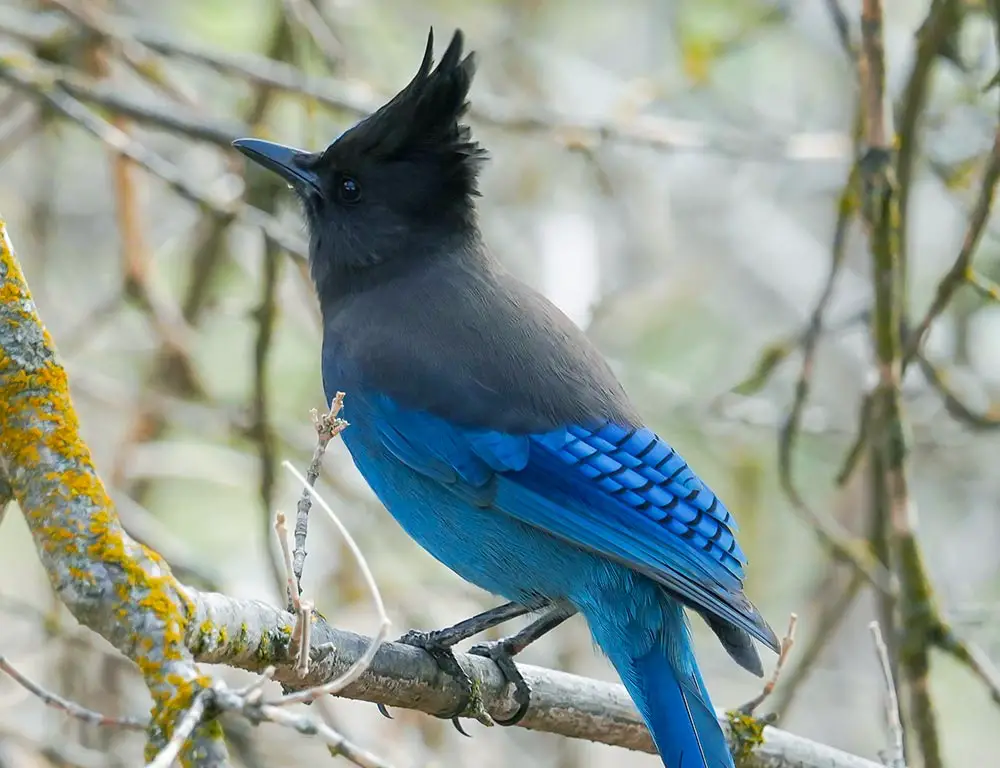
Steller’s jay is a beautiful and colorful bird native to western North America and the mountains of Central America.
It has a distinctive long crest that sets it apart from other birds, with its blue feathers streaked with black, white, gray, and brown markings.
This species is closely related to the blue jays found in eastern North America but can be distinguished by their longer crests.
They are known for being highly vocal birds who like to make loud calls throughout forests they inhabit as well as stealing food from unsuspecting mammals or raiding bird feeders when given the chance.
Steller’s Jays have adapted well to human presence in areas they populate making them great backyard visitors if you’re lucky enough.
Scientific classification:
| Kingdom | Animalia |
| Phylum | Chordata |
| Class | Aves |
| Order | Passeriformes |
| Family | Corvidae |
| Genus | Cyanocitta |
| Species | C. stelleri |
Also Featured In: Alaska Birds, Birds That Live around Seattle
19. Lazuli Bunting
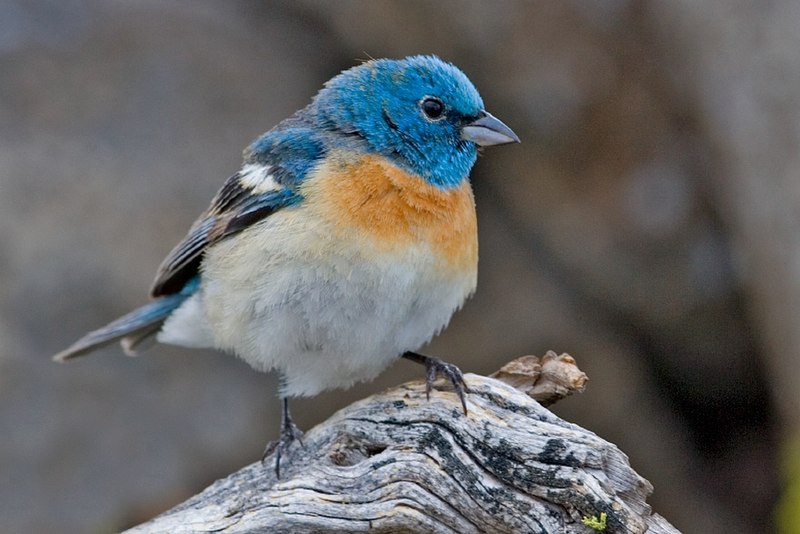
The Lazuli Bunting is a beautiful North American songbird, aptly named for its bright blue head and back that resemble the gemstone lapis lazuli.
With white wing bars contrasting against its light rusty breast and white belly, it stands out from other birds.
Measuring only 11-13 centimeters in length, this small bird holds an unmistakable beauty with distinct coloring which sets it apart from eastern or western bluebirds of similar size.
The male’s brilliant hues have made them popular among birdwatchers throughout the United States as they migrate along their yearly route each spring and summer to breed before returning southward again come fall.
Scientific classification:
| Kingdom | Animalia |
| Phylum | Chordata |
| Class | Aves |
| Order | Passeriformes |
| Family | Cardinalidae |
| Genus | Passerina |
| Species | P. amoena |
Also Featured In: birds of Idaho, Blue Birds that You’ll Find in Utah
20. Mexican Jay
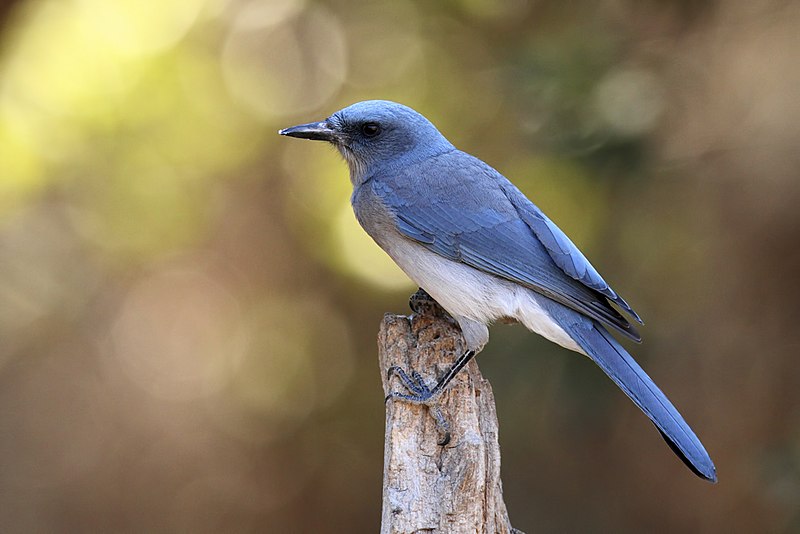
The Mexican jay, previously known as the gray-breasted jay, is a species of New World jay native to regions including the Sierra Madre Oriental, Sierra Madre Occidental, and Central Plateau of Mexico.
It also inhabits select areas in the southwestern United States. The Mexican jay was recently split into two species, with the other being known as the Transvolcanic jay.
These birds are known for their striking blue plumage and are often found in small groups.
They are opportunistic feeders, consuming a wide variety of food, including insects, fruits, seeds, and even small vertebrates.
The Mexican jay’s habitat includes woodlands, forests, and desert scrub. Due to habitat loss and fragmentation, their population is slowly declining, making them a conservation concern.
Scientific classification:
| Kingdom | Animalia |
| Phylum | Chordata |
| Class | Aves |
| Order | Passeriformes |
| Family | Corvidae |
| Genus | Aphelocoma |
| Species | A. wollweberi |
Also Featured In: Most Common Birds of Nuevo Leon, Birds You’ll Find in Sonoran
21. Blue Mockingbird
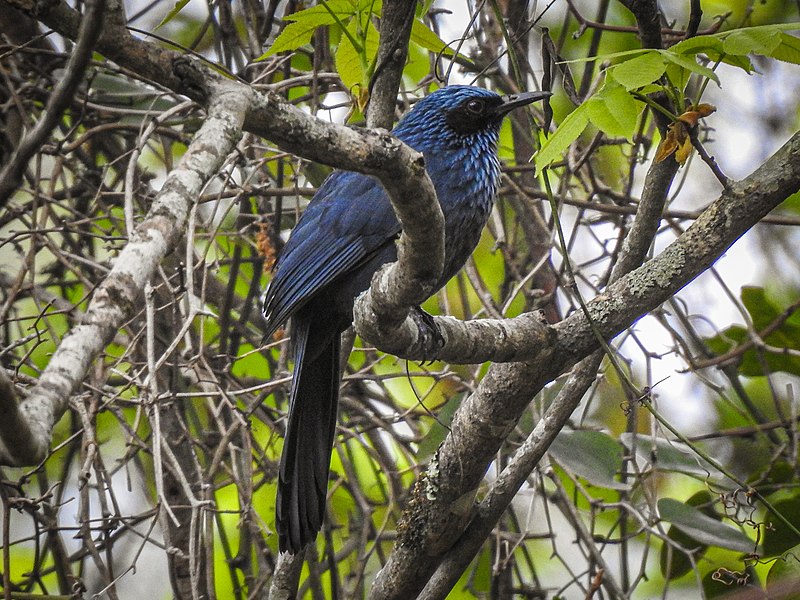
The blue mockingbird is a striking bird found only in Mexico, though rare sightings have been reported in the southern United States. Its natural habitats include dry and montane forests, as well as degraded former forest areas.
With its vibrant blue coloring, this bird is easily recognizable by its uniform blue back, tail, wings, head, and underbelly. It belongs to the family Mimidae and is known for its impressive mimicking abilities.
Despite its beauty, this species is considered Near Threatened due to habitat loss and degradation.
The blue mockingbird serves as a reminder of the importance of conservation efforts to protect our planet’s diverse and unique wildlife.
Scientific classification:
| Kingdom | Animalia |
| Phylum | Chordata |
| Class | Aves |
| Order | Passeriformes |
| Family | Mimidae |
| Genus | Melanotis |
| Species | M. caerulescens |
Also Featured In: Birds that Live in Jalisco Birds, Birds that Live in Morelos
22. Island Scrub Jay
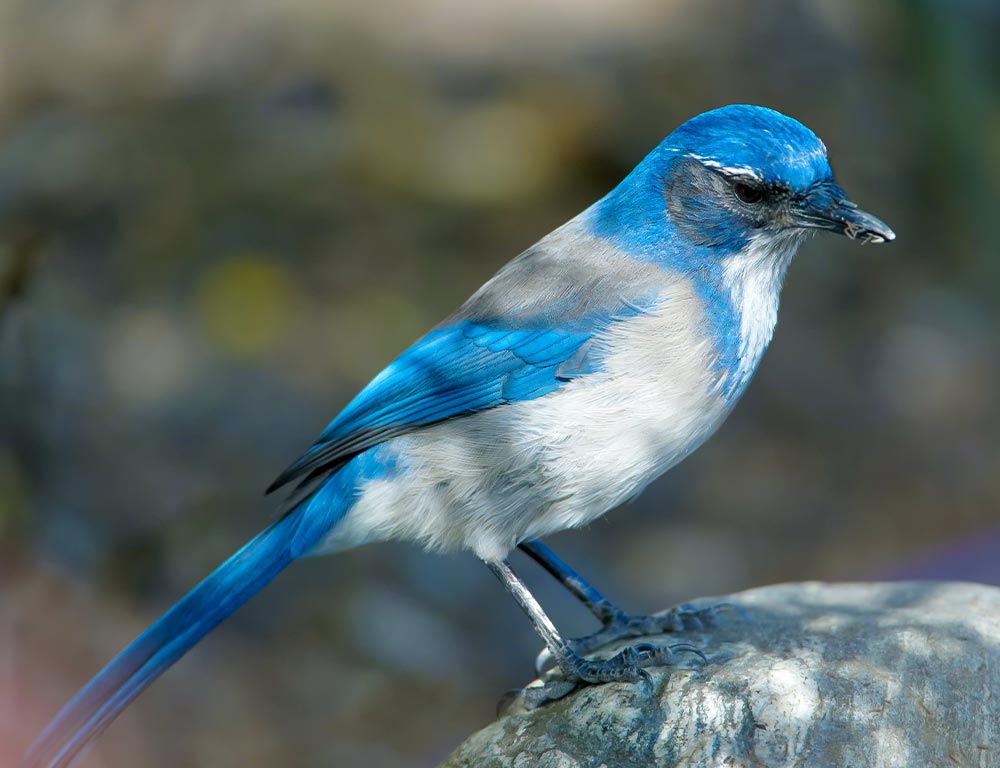
The island scrub jay is a unique bird species that can only be found on Santa Cruz Island off the coast of Southern California. It is an insular endemic land bird, which means that it is the only one of its kind in the continental U.S. and Canada.
These jays are closely related to the California scrub jay. They are also known as Santa Cruz jays and have a range of distinct calls and behaviors. These birds are omnivores and feed on a variety of insects, fruits, and seeds.
They are known to be curious and will investigate shiny objects. The island scrub jay population has experienced significant declines due to habitat loss and predation from introduced species, such as feral cats.
Conservation efforts are underway to protect this unique and important bird species.
Scientific classification:
| Kingdom | Animalia |
| Phylum | Chordata |
| Class | Aves |
| Order | Passeriformes |
| Family | Corvidae |
| Genus | Aphelocoma |
| Species | A. insularis |
Also Featured In: Anacapa Island Birds You Need To Know,